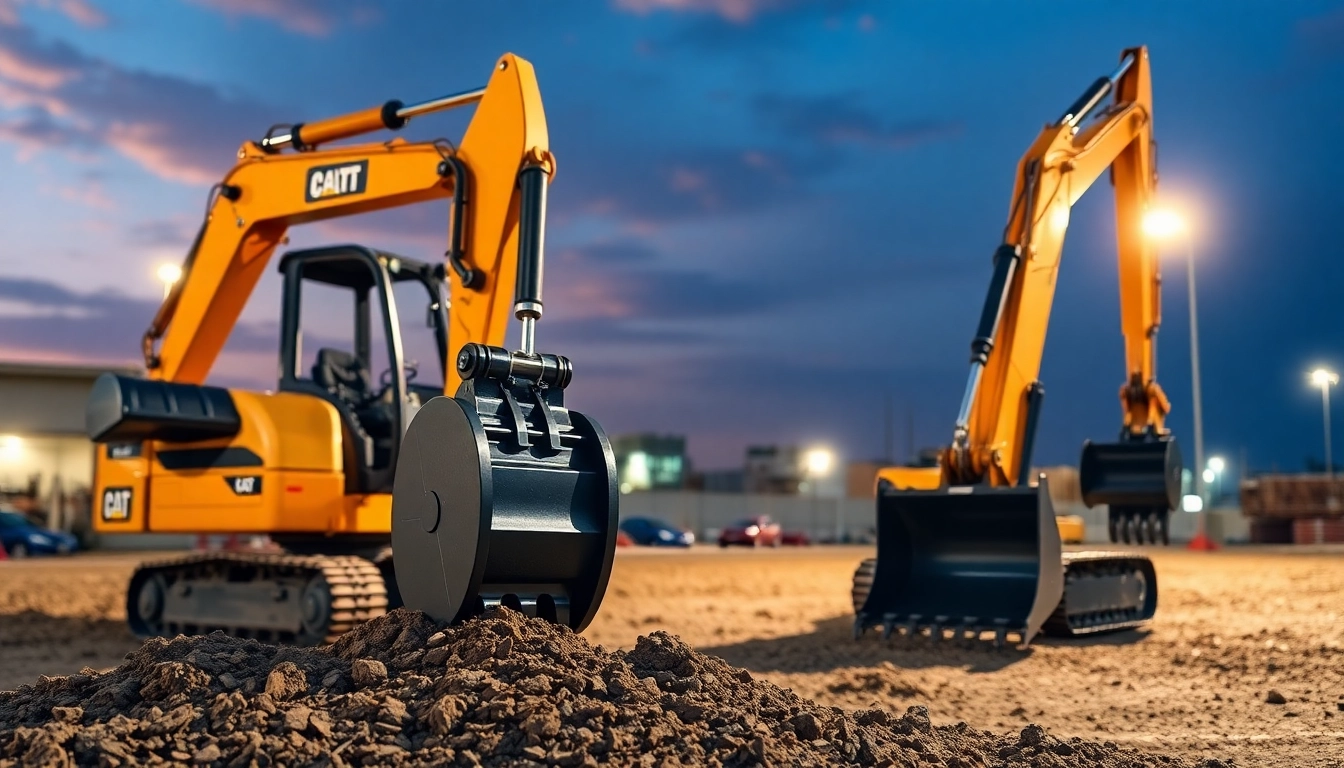
Understanding Mini Excavator Attachments
What are Mini Excavator Attachments?
Mini excavators have revolutionized the heavy machinery landscape, offering exceptional versatility and efficiency for various jobs, from landscaping to construction. At the heart of this adaptability are mini excavator attachments, which are implements designed to enhance the functionality of a mini excavator. Mini excavator attachments exchange the machine’s standard bucket for a broader array of tools, enabling operators to carry out diverse tasks without needing multiple machines. Whether it’s digging, hauling, grading, or demolishing, these attachments optimize performance and productivity, making mini excavators a valuable asset in any job site.
Types of Mini Excavator Attachments Available
There is a wide range of mini excavator attachments available, each designed for specific tasks. Understanding these types can help operators choose the right equipment for their needs:
- Buckets: These are one of the most common attachments, available in various sizes and shapes for different digging and hauling jobs. Standard buckets, trenching buckets, and grading buckets serve various purposes, from excavation to material handling.
- Augers: Ideal for drilling holes in the ground, augers are particularly useful for planting trees, installing fences, or creating foundations.
- Thumbs: These attachments work in conjunction with buckets to enhance grasping capabilities, allowing operators to pick up larger objects easily.
- Brush Cutters: A bush cutter attachment is used for clearing overgrown vegetation and brush from job sites, enabling efficient land maintenance.
- Trenchers: Designed for creating narrow trenches for utilities or drainage systems, trenchers can significantly reduce manual labor.
- Grapples: These are excellent for handling bulky materials like logs, debris, or pipe with precision and safety.
How Mini Excavator Attachments Enhance Productivity
The integration of the right mini excavator attachments can dramatically boost productivity on construction sites. Attachments allow a single machine to perform multiple roles, which conserves both time and resources. For instance, instead of switching between different equipment for digging and material handling, an operator can seamlessly transition between tasks using various attachments. This multitasking capability reduces downtime and increases the efficiency of operations, which can lead to substantial cost savings over time.
Choosing the Right Mini Excavator Attachments
Factors to Consider When Selecting Attachments
Choosing the correct attachment for your mini excavator requires careful consideration of several factors:
- Equipment Compatibility: Not all attachments are suitable for every mini excavator. It’s imperative to ensure that the attachment matches the specifications of your machine, including weight capacity and hydraulic power.
- Job Requirements: Clearly define the tasks you plan to undertake. This could influence whether you need a responsive bucket for digging or a grapple for moving heavy materials.
- Durability and Quality: Investing in high-quality attachments can save money in the long run. Look for attachments made from high-grade materials that can withstand tough conditions.
- Brand Support: Reputable brands often provide more reliable customer service and support in case of issues, which can be an essential factor in the decision-making process.
Top Brands and Their Offerings
Several leading brands specialize in mini excavator attachments, each offering unique features and benefits:
- Bobcat: Known for their quality and innovative designs, Bobcat attachments offer durability and compatibility with a wide range of mini excavators.
- AMI Attachments: AMI produces a selection of attachments that focus on performance and ease of use, making them a favorite among operators.
- Rhinox Group: They specialize in manufacturing attachments that prioritize durability and efficiency, catering to the heavy-duty sector.
- Spartan Equipment: Offering a range of American-made attachments, Spartan is renowned for quality and reliability.
Reading Reviews and Comparing Features
Before finalizing your attachment purchase, it’s advisable to conduct thorough research. Reading customer reviews and comparing product specifications can provide insights into the performance and usability of specific attachments. Online forums, manufacturer websites, and customer feedback can highlight the strengths and weaknesses of various options. Additionally, videos showcasing the attachments in operation may help visualize their capabilities and impacts on productivity.
Benefits of Using Mini Excavator Attachments
Increased Versatility on the Job
One of the most significant benefits of using mini excavator attachments is the increased versatility they offer. By equipping a mini excavator with the right attachments, operators can switch tasks with ease, handling everything from excavation to landscaping to material hauling, all with the same machine. This adaptability allows operators to tackle more jobs efficiently, making the mini excavator a multipurpose tool on the job site.
Cost Efficiency and Time Savings
Investing in mini excavator attachments can lead to significant cost efficiency. Since these attachments are designed to perform specific tasks effectively, they reduce the need for additional equipment rental or purchase. Additionally, the time saved from switching equipment and optimizing workflow with the right attachments translates into lower project costs and increased output, contributing to overall profitability.
Improved Safety and Ergonomics
Modern mini excavator attachments are engineered with safety and ease of use in mind. Many are designed to reduce operator strain through ergonomic design, effectively minimizing the risk of injury. Moreover, with optimized attachments, job site risks decrease as operators are better equipped to handle tasks with precision, reducing the chances of accidents.
Installation and Maintenance of Mini Excavator Attachments
How to Properly Install Attachments
Installing mini excavator attachments requires careful attention to safety and precision to ensure that the equipment is secure and functional. Here’s a step-by-step guide:
- Read the Manual: Always begin by consulting the operator’s manual for both your mini excavator and the attachment. This will provide essential instructions and safety guidelines.
- Turn Off Equipment: Before installation, ensure that the mini excavator is turned off, the keys are removed, and the hydraulic system is depressurized to prevent accidental activation.
- Attach the Quick Coupler: Many mini excavators are equipped with quick couplers. Align the attachment with the coupling mechanism and ensure that it locks securely into place.
- Check Hydraulic Connections: Properly connect any hydraulic lines, ensuring there are no leaks. It’s crucial for performance and safety.
- Perform a Test: Once installed, perform a slow test operation to ensure everything is functioning correctly before commencing full operations.
Routine Maintenance Tips for Longevity
Maintaining mini excavator attachments is critical for ensuring their longevity and reliable performance. Regular maintenance can include:
- Inspecting connections and fittings for wear or damage.
- Cleaning attachments regularly to prevent buildup of dirt and debris.
- Lubricating moving parts as per the manufacturer’s recommendations.
- Storing attachments in a dry place to prevent corrosion and rust.
Common Issues and Troubleshooting
Even with routine maintenance, users might encounter common issues with attachments. Here are some common problems and troubleshooting steps:
- Hydraulic Leaks: If you notice hydraulic fluid leaking, inspect hoses and fitting connections for signs of wear. Tightening connections or replacing worn parts may resolve the issue.
- Attachment Won’t Lock: Ensure that the quick coupler is free of debris and properly aligned. If the problem persists, consult the manual for alignment instructions.
- Reduced Performance: Inspect hydraulic lines and filters for blockages. Changing filters and ensuring clean hydraulic fluid can often restore performance.
Maximizing Performance with Mini Excavator Attachments
Best Practices for Using Attachments Effectively
To make the most of mini excavator attachments, consider the following best practices:
- Train Operators: Ensure that all operators are trained not only in the use of the excavators but also in the specific attachments for safety and operational efficiency.
- Plan Work Efficiently: Create a job plan that maximizes the use of different attachments. Organizing tasks that can be accomplished with the same attachment can save time.
- Regularly Review Performance: Conduct regular assessments to evaluate how well attachments are performing. This can guide decisions about future purchases or adjustments needed to existing equipment.
Repair vs. Replacement: Making the Right Call
Determining whether to repair or replace an attachment can sometimes be challenging. Here are some considerations:
- Cost of Repair: If the repair costs exceed half the price of a new attachment, replacing it might be more economical in the long run.
- Usage and Wear: Assess how much the attachment has been used. Frequent use indicating wear may warrant replacement rather than a temporary fix.
- Performance Goals: If the attachment cannot meet your operational standards post-repair, it’s time to consider an upgrade.
Future Trends in Mini Excavator Attachments
The field of mini excavator attachments is continually evolving, with several trends shaping its future:
- Enhanced Technology: Advancements in technology are leading to more innovative designs, such as attachments that can be controlled remotely via smart devices, providing operators with increased safety and efficiency.
- Eco-Friendly Options: As sustainability practices become more ingrained in construction, manufacturers are focusing on creating attachments that reduce carbon footprints and are made from recycled materials.
- Customization: The demand for attachments tailored to specific tasks is rising, allowing contractors to optimize performance based on projects’ unique requirements.





